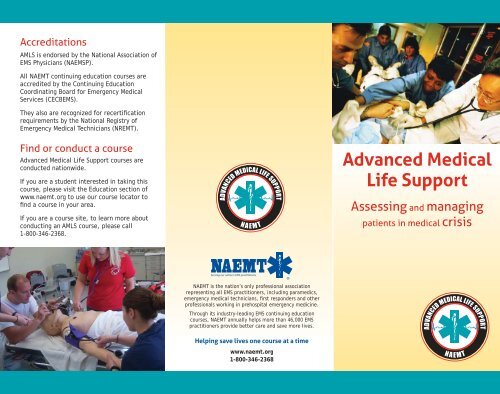Advanced Medical Life Support
Create successful ePaper yourself
Turn your PDF publications into a flip-book with our unique Google optimized e-Paper software.
Accreditations<br />
AMLS is endorsed by the National Association of<br />
EMS Physicians (NAEMSP).<br />
All NAEMT continuing education courses are<br />
accredited by the Continuing Education<br />
Coordinating Board for Emergency <strong>Medical</strong><br />
Services (CECBEMS).<br />
They also are recognized for recertifi cation<br />
requirements by the National Registry of<br />
Emergency <strong>Medical</strong> Technicians (NREMT).<br />
Find or conduct a course<br />
<strong>Advanced</strong> <strong>Medical</strong> <strong>Life</strong> <strong>Support</strong> courses are<br />
conducted nationwide.<br />
If you are a student interested in taking this<br />
course, please visit the Education section of<br />
www.naemt.org to use our course locator to<br />
fi nd a course in your area.<br />
If you are a course site, to learn more about<br />
conducting an AMLS course, please call<br />
1-800-346-2368.<br />
NAEMT is the nation’s only professional association<br />
representing all EMS practitioners, including paramedics,<br />
emergency medical technicians, fi rst responders and other<br />
professionals working in prehospital emergency medicine.<br />
Through its industry-leading EMS continuing education<br />
courses, NAEMT annually helps more than 46,000 EMS<br />
practitioners provide better care and save more lives.<br />
Helping save lives one course at a time<br />
www.naemt.org<br />
1-800-346-2368<br />
<strong>Advanced</strong> <strong>Medical</strong><br />
<strong>Life</strong> <strong>Support</strong><br />
Assessing and managing<br />
patients in medical crisis
Assessing and managing<br />
patients<br />
While on the job, EMS practitioners encounter<br />
patients experiencing a wide spectrum of<br />
medical crises. How can they quickly and<br />
accurately assess patients to provide the<br />
best care?<br />
To provide an accurate diagnosis and treatment<br />
plan, EMS practitioners need to know<br />
how to quickly and best assess the scene, the<br />
patient’s medical history and current<br />
condition.<br />
The National Association of Emergency<br />
<strong>Medical</strong> Technicians (NAEMT)’s <strong>Advanced</strong><br />
<strong>Medical</strong> <strong>Life</strong> <strong>Support</strong> (AMLS) course is the fi rst<br />
education program that fully addresses how<br />
to best assess and manage the most common<br />
medical crises in patients, offering a “think<br />
outside the box” methodology.<br />
AMLS is the most comprehensive EMS<br />
continuing education course addressing the<br />
assessment and management of patients.<br />
The AMLS course<br />
AMLS emphasizes the use of scene size-up,<br />
history, interactive group discussion on<br />
potential treatment strategies, and physical<br />
exam to systematically rule out and consider<br />
possibilities and probabilities in treating<br />
patients’ medical crises. The course offers<br />
an initial assessment-based approach that<br />
progresses to a diagnostic-based approach to<br />
quickly develop the best treatment plan.<br />
AMLS is for all levels of practitioners with a<br />
strong commitment to patient care, including<br />
fi rst responders, emergency medical technicians,<br />
paramedics, nurses, nurse practitioners,<br />
physician assistants, nurse anesthetists and<br />
physicians.<br />
When given a case presentation, students who<br />
take AMLS will learn to:<br />
��Identify and manage life-threatening<br />
presentations for a variety of medical<br />
emergencies, while considering comprehensive<br />
patient history, focused physical exam, and<br />
diagnostic fi ndings.<br />
��Demonstrate with profi ciency the<br />
application of the AMLS Assessment Pathway to<br />
determine appropriate differential diagnoses<br />
and management strategies.<br />
��Compare and contrast the concepts of<br />
clinical decision-making, pattern recognition,<br />
and clinical reasoning used in the determination<br />
of differential diagnoses.<br />
The AMLS curriculum<br />
The course discusses common medical crises,<br />
introduces the AMLS Assessment Pathway, and<br />
presents specifi c cases and differential diagnoses<br />
and management strategies for each. The course<br />
includes lecture, discussion and skills stations, so<br />
students leave with thorough knowledge and handson<br />
skills to perform accurate physical examinations<br />
and provide best treatment to patients.<br />
The curriculum covers the signs, symptoms and<br />
pathophysiology of:<br />
��Altered mental status and neurologic disorders<br />
— Addresses patients’ mental status and abnormal<br />
neurological function and how to perform accurate<br />
basic neurologic physical examinations<br />
��Respiratory dysfunction — Examines respiratory<br />
distress versus respiratory failure, the variety of<br />
respiratory disorders, and the use of basic and<br />
advanced airway adjuncts to manage the airway<br />
and increase oxygenation and ventilation<br />
��Shock — Discusses compensated and uncompensated<br />
shock and appropriate treatment strategies<br />
��Chest discomfort — Emphasizes disorders,<br />
diagnoses that require emergency interventions,<br />
and the interpretation of fi ndings for a 12-lead<br />
ECG into the AMLS Assessment Pathway<br />
��Endocrine, metabolic and environmental<br />
disorders — Concentrates on the disorders that<br />
require emergency interventions<br />
��Abdominal discomfort — Deals with a variety<br />
of presentations, disorders and issues, and<br />
emegency management<br />
��Infectious disease — Addresses differential diagnoses<br />
that require emergency interventions<br />
and demonstrates use of body substance isolation<br />
��Toxicologic emergencies, hazardous materials<br />
and weapons of mass destruction — Describes<br />
exposures, toxidromes and safety concerns that<br />
require emergency interventions


